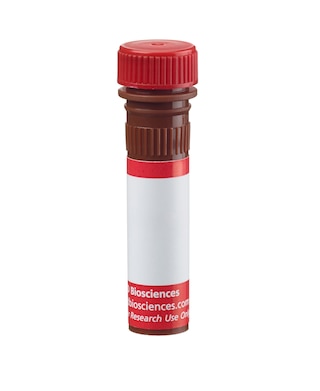Old Browser
Looks like you're visiting us from {countryName}.
Would you like to stay on the current country site or be switched to your country?




Flow cytometric analysis of CD53 expression on mouse splenocytes. Mouse splenic leucocytes were preincubated with Purified Rat Anti-Mouse CD16/CD32 antibody (Mouse BD Fc Block™) (Cat. No. 553141/553142). The cells were then stained with either Alexa Fluor® 647 Mouse IgM, κ Isotype Control (Cat. No. 560892; dashed line histogram) or Alexa Fluor® 647 Rat Anti-Mouse CD53 antibody (Cat. No. 564931; solid line histogram). The fluorescence histogram showing CD53 expression (or Ig Isotype control staining) was derived from gated events with the forward and side light-scatter characteristics of viable leucocytes. Flow cytometric analysis was performed using a BD LSRFortessa™ Cell Analyzer System.


BD Pharmingen™ Alexa Fluor® 647 Rat Anti-Mouse CD53

Regulatory Status Legend
Any use of products other than the permitted use without the express written authorization of Becton, Dickinson and Company is strictly prohibited.
Preparation And Storage
Product Notices
- Since applications vary, each investigator should titrate the reagent to obtain optimal results.
- An isotype control should be used at the same concentration as the antibody of interest.
- Caution: Sodium azide yields highly toxic hydrazoic acid under acidic conditions. Dilute azide compounds in running water before discarding to avoid accumulation of potentially explosive deposits in plumbing.
- The Alexa Fluor®, Pacific Blue™, and Cascade Blue® dye antibody conjugates in this product are sold under license from Molecular Probes, Inc. for research use only, excluding use in combination with microarrays, or as analyte specific reagents. The Alexa Fluor® dyes (except for Alexa Fluor® 430), Pacific Blue™ dye, and Cascade Blue® dye are covered by pending and issued patents.
- Alexa Fluor® is a registered trademark of Molecular Probes, Inc., Eugene, OR.
- Alexa Fluor® 647 fluorochrome emission is collected at the same instrument settings as for allophycocyanin (APC).
- For fluorochrome spectra and suitable instrument settings, please refer to our Multicolor Flow Cytometry web page at www.bdbiosciences.com/colors.
- Please refer to www.bdbiosciences.com/us/s/resources for technical protocols.
Companion Products






The OX-79 antibody reacts with CD53, a 35-45-kDa member of the Transmembrane 4-pass protein superfamily (TM4SF). As in the human, mouse peripheral leukocytes express CD53 mRNA and protein, and erythrocytes and nonhematopoietic cells do not. However, the distribution of CD53 in the mouse and rat thymus differs from that in the human. In the mouse, most CD4+8- and major subsets of CD4- CD8- (double-negative) and CD4- CD8+ thymocytes express CD53, while most cortical CD4+ CD8+ (double-positive) thymocytes are CD53-low or CD53-negative. CD53 expression can be induced in double-positive thymocytes by cross-linking of their T-cell receptors with anti-TCR mAb or peptide-pulsed antigen-presenting cells. There is a strong correlation between positive selection of thymocytes and CD53 expression. Its association with CD2 and a tyrosine phosphatase in rat T lymphocytes and with CD19, CD21, HLA-DR, and other TM4SF proteins in human B lymphocytes suggests that CD53 is involved in leukocyte signal transduction.
Development References (4)
-
Angelisová P, Hilgert I, Horejsí V. Association of four antigens of the tetraspans family (CD37, CD53, TAPA-1, and R2/C33) with MHC class II glycoproteins. Immunogenetics. 1994; 39(4):249-256. (Biology). View Reference
-
Carmo AM, Wright MD. Association of the transmembrane 4 superfamily molecule CD53 with a tyrosine phosphatase activity. Eur J Immunol. 1995; 25(7):2090-2095. (Biology). View Reference
-
Puls KL, Hogquist KA, Reilly N, Wright MD. CD53, a thymocyte selection marker whose induction requires a lower affinity TCR-MHC interaction than CD69, but is up-regulated with slower kinetics. Int Immunol. 2002; 14(3):249-258. (Biology). View Reference
-
Tomlinson MG, Hanke T, Hughes DA, et al. Characterization of mouse CD53: epitope mapping, cellular distribution and induction by T cell receptor engagement during repertoire selection. Eur J Immunol. 1995; 25(8):2201-2205. (Immunogen: Western blot). View Reference
Please refer to Support Documents for Quality Certificates
Global - Refer to manufacturer's instructions for use and related User Manuals and Technical data sheets before using this products as described
Comparisons, where applicable, are made against older BD Technology, manual methods or are general performance claims. Comparisons are not made against non-BD technologies, unless otherwise noted.
For Research Use Only. Not for use in diagnostic or therapeutic procedures.
Report a Site Issue
This form is intended to help us improve our website experience. For other support, please visit our Contact Us page.